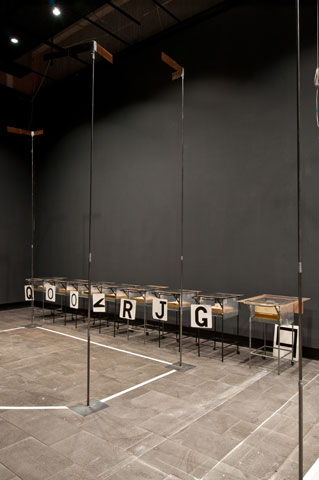John Hurrell – 26 September, 2009
Hung from clunky grey screens, these incorporate faked sociological and statistical charts or graphs, culled from enlarged text book pages. Made with a wide range of traditional media, including collage, paint, pencil, ink, tape, charcoal and crayon, they look like very odd archaic posters from some very peculiar ranting institution.
et al
That’s obvious! That’s right! That’s true!
Curated by Jennifer Hay
23 July - 22 November 2009
Andrew Paul Wood has already contributed a review of this show that has sparked off some excellent discussion involving myself and Ralph Paine - over his comparison of et al. with Richard Rorty. I said that et al. are not extreme antifoundationalists like Rorty, and Ralph replied that Andrew was covered by his discussion of irony.
Irony is not part of et al.’s current game-plan in my view. Look at the title of this show. I think it is dead straight. No smirks or bulging cheeks anywhere - it is earnest. Why is that? Because though it seems to be a classic et al. installation display it really is about the old-timey skills of drawing. It is a fantastic, virtuoso drawing exhibition - albeit an unusual one. None of the art commentators have noticed this yet.
So the point of that title? What is so damned obvious, correct and truthful? A large suite of framed images - captions pertaining to the global crisis and state of suffering humanity in general - that’s what. Hung from clunky grey screens, these incorporate faked sociological and statistical charts or graphs, culled from enlarged text book pages. Made with a wide range of traditional media, including collage, paint, pencil, ink, tape, charcoal and crayon, they look like very odd archaic posters from some very peculiar ranting institution.
Here are some headings et al. use in the drawings, strung together in a line:
Recent events and the state of the world. Example of continuing conflict. Common misunderstandings, motives and choice. Conflict induced outcomes. One world: keys to the immediate future of humanity. Assimilation: ideology, social position and disposition. Will the matters on hand delay or hasten the process of responsibility and human love?
Not a belly laugh anywhere amidst the dark shadows and lumbering screens. It is an unabashedly community-oriented project. One obviously unorthodox. And in its centre is a small stage on which are stacked free copies of et al.’s publishing venture: The New Zealand Altruism Review (June 2009), designed to encourage constructive and positive social change. In other words, political reform without satire.
One of the ways the show is impressive is its use of height, the way the stud of the exhibition space has been exploited. Signs on towering metal poles like lampposts on street corners, dismantled ventilation chutes, the small stage, four odd projection screens that are a little like flimsy urinals made of canvas: they all condense the cavelike atmosphere to make it intimate and less sprawling. Less like a hangar.
Around the corner far away from the central downstairs CAG corridor, in a row of alphabet-coded fish tanks on trolleys, are cardboard models of rooms. Their rectangular shapes reflect the lifesize floorplan drawn on the gallery floor with thick white tape. These roofless toy sheds seem to be metaphors for individual selves. In isolation and exposed in full view, they are cut off from community links indicated by the joined up tape lines on the floor and the content of the drawings.
Great as That’s Obvious! That’s Right! That’s True! is, it is perhaps too successful - for the drawings are technically too subtle and conceptually welded to the installation to get noticed. That is an odd thing to say I know, and it is perhaps wearingly trivial to suggest that their sophistication will only really be grasped when they are removed from their contextualising project and examined in isolation. Still, the seemingly casual effortlessness of their production I think ensures they will attract a following of new et al. enthusiasts who previously found the work too raw or confrontational. Like Bill Hammond’s practice when his work changed after the Auckland Islands trip, there is a new manual dexterity in this work - an unforseen confidence - matched perhaps by a new optimism in the missionlike subject matter. I’m not sure if it’s my imagination but there seems to be some kind of turning point.


 Two Rooms presents a program of residencies and projects
Two Rooms presents a program of residencies and projects Advertising in this column
Advertising in this column



This Discussion has 0 comments.
Comment
Participate
Register to Participate.
Sign in
Sign in to an existing account.